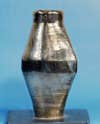ISS Could Get its Own Electron-Beam Fabrication 3-D Printer
Every good futuristic sci-fi narrative has its version: Star Trek had the replicator that produced Picard’s piping hot Earl Grey...

Electron Beam Freeform Fabrication
Every good futuristic sci-fi narrative has its version: Star Trek had the replicator that produced Picard’s piping hot Earl Grey from what appeared to be thin air, and Forbidden Planet had Robbie the Robot, who generated entire luncheons from the chemical lab in his nether regions. But NASA scientists have come many real-world steps closer to creating something from nothing, via a process called electron beam freeform fabrication, and a version of the technology will soon be going to the International Space Station for testing.

A Part Fabricated With EBF3
Electron Beam Freeform Fabrication, or EBF3, takes place in a vacuum chamber in which an electron beam is focused on a source of metal that is constantly fed into the beam. The electron beam melts the metal atop a rotating surface, applying the molten feedstock in layers as directed by a detailed 3-D drawing of the object being produced. The process continues until the object is done, rendered completely from drawing to usable metal part.
Though not quite as versatile as the Enterprise’s replicator, EBF3 technology has myriad commercial applications aside from its scientific implications. All one needs to fabricate a part for, say, a commercial airliner or a medical device is a 3-D rendering of the part and a feedstock that is compatible with the electron beam (that is, something the beam can liquify). The drawing must be highly in-depth, however, breaking the object into layers that the EBF3 machine can understand and accommodate.
But once that drawing is made once, the airline manufacturer or the device maker can conjure that part on demand and on-site, saving money and time. Furthermore, because layering together a part from molten metal requires less waste than machining a part from a solid block, EBF3 is exponentially more environmentally friendly than conventional fabrication methods. Some aircraft builders machine 300-pound parts from 6,000-pound blocks of titanium; EBF3 could produce the same part from just 350 pounds, saving 5,650 pounds of titanium that would normally have to be recycled.
EFB3 can also feed two different feedstocks into the machine at once, opening up more opportunities for innovation. For instance, part makers could embed a strand of fiberoptic cable inside a part, allowing the placement of sensors in places where it was previously impossible.
But let’s not forget the sci-fi implications as well. Future crews manning a lunar base could use EBF3 to create parts and tools as needed (rather than ordering them from Earth a quarter million miles away). As for feedstocks, they could scrap their landing crafts, but they might also be able to mine them from the moon’s soil, bringing sustainable space dwelling that much closer to reality.
The EBF3 equipment tested on the ground is quite bulky, but a scaled down version was created and subsequently flown to near-weightlessness on NASA’s Reduced Gravity Aircraft. The next step should be a trip to the ISS, though the EBF3 is still waiting for a spot on a mission manifest. While it may not produce the crew’s afternoon tea, it could someday supply a critical part at a crucial moment. That’s more than we can say for the replicator.